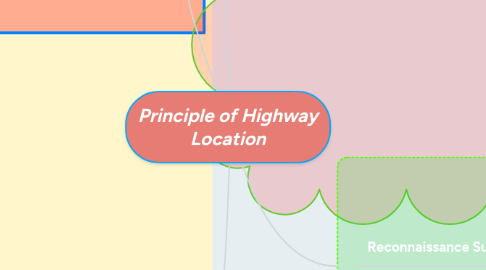
1. Preliminary Location Survey
1.1. • The positions of the feasible routes are set as closely as possible by establishing all the control points and determining preliminary vertical and horizontal alignments for each.
1.2. Preliminary alignments are used to evaluate the economic and environmental feasibility of the alternative routes.
1.3. • Economic evaluation
1.3.1. To determine the future effect of investing the resources necessary to construct the highway
1.3.2. Method of benefit-cost ratio is used for this evaluation
1.3.3. Factors usually taken into consideration
1.3.3.1. road user costs
1.3.3.2. construction costs
1.3.3.3. maintenance costs
1.3.3.4. road user benefits
1.3.3.5. Any dis-benefits, which may include adverse impacts due to dislocation of families, businesses, and so forth
1.4. • Environmental evaluation
1.4.1. An evaluation on the impact of the environment due to the construction of the highway
1.4.2. Environment includes plant, animal, and human communities and encompasses social, physical, natural, and man-made variables
1.4.3. Local legislation has been enacted that sets forth the requirements of the environmental evaluation required for different types of projects
1.4.4. The best alternative, based on all the factors considered, is then selected as the preliminary alignment of the highway
2. Final Location Survey
2.1. Horizontal and vertical alignment determined and position of structure and drainage channels located
2.2. Used to set out the point of intersection and fit suitable horizontal curve between these
2.3. Trial and Error process
2.3.1. Engineering and aesthetic factor
2.3.2. Designer opinion
2.4. The process
2.4.1. Splines
2.4.1.1. Flexible plastic guide that can be bent into different position
2.4.1.2. Used to lay out different curvilinear alignments
2.4.2. Curve templates
2.4.2.1. Transparencies giving circular curves
2.4.2.2. three-center compound curves
2.4.2.3. Spiral curves templates
2.5. Availability of computer
2.5.1. Enable the designer to have a driver's eye view of both the horizontal and vertical alignments
3. Office study of Existing Information
3.1. Carried out indoor where the study of all available data of the area in which the road to be constructed is required
3.1.1. - Engineering
3.1.1.1. topography
3.1.1.2. geography
3.1.1.3. climate
3.1.1.4. traffic volume
3.1.2. Social and Demographic
3.1.2.1. Land use
3.1.2.2. zoning pattern
3.1.3. Environmental
3.1.3.1. types of wildlife
3.1.3.2. archaeological sites
3.1.3.3. possible effect of pollutions
3.1.4. - Economic
3.1.4.1. Unit cost for construction and trend of agricultural
3.1.4.2. commercial
3.1.4.3. industrial activities
3.2. At the completion of this phase, the engineer will be able to select general areas through which the highway can traverse
4. Reconnaissance Survey
4.1. The purpose is to identify possible routes by a stereoscopic examination of the aerial photograph, taking into consideration factors such as:
4.1.1. Terrain and soil conditions
4.1.2. Serviceability of route to industrial and population area
4.1.3. Crossing of other transportation facilities, such as river, railroads and highways.
4.1.4. Directness of route
